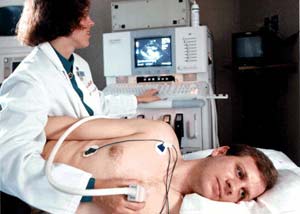Echocardiogram procedure/test - heart/cardiac

What is Echocardiogram
Echocardiogram is a noninvasive, diagnostic ULTRASOUND examination of the HEART that can show the heart’s structure and, when combined with Doppler technology, the flow of BLOOD through the heart’s chambers and the CORONARY ARTERIES. Echocardiogram is most effective for evaluating VALVULAR HEART DISEASE and structural malformations of the heart such as major congenital deformities, septal defects, and patent ductus arteriosus (PDA).
There is no preparation for a echocardiogram, which uses soundwaves to create visual images. For a transthoracic echocardiogram (TTE), the ultrasonographer places a small amount of gel on the SKIN of the chest to improve contact with the transducer, the device that sends and receives the sound signals. The ultrasonographer then moves the transducer over the surface of the skin. For a transesophageal echocardiogram (TEE), the ultrasonographer numbs the back of the THROAT and passes a narrow cable with a transducer at the tip down the throat into the ESOPHAGUS. A TEE places the transducer as close as possible to the heart, usually to obtain specific images such as to detect septal defects or certain valve malformations.
A computer converts the sound signals into two- or three-dimensional images. Typically the cardiologist does an ELECTROCARDIOGRAM (ECG) at the same time, to correlate the visual images from the echocardiogram with the heart’s electrical activity. Sometimes the cardiologist will combine the echocardiogram with an injection of dye, administered intravenously, to better highlight the inner structures of the heart. Echocardiogram or TTE takes 10 to 20 minutes and there is no recovery time necessary after the procedure. People undergoing TEE generally receive sedation before the procedure begins so go to a recovery area after the TEE until fully awake from the sedative and the cardiologist is satisfied there will be no adverse effects.
| CONDITIONS ECHOCARDIOGRAM CAN HELP DIAGNOSE OR MONITOR | |
|---|---|
| AMYLOIDOSIS | aortic ANEURYSM |
| AORTIC STENOSIS | CARDIAC TAMPONADE |
| CARDIOMYOPATHY | congenital heart malformations |
| ENDOCARDITIS | HEART FAILURE |
| HEMACHROMATOSIS | mitral valve prolapse |
| MYOCARDIAL INFARCTION | MYOCARDITIS |
| MYXOMA | patent ductus arteriosus |
| PERICARDITIS | PRIMARY PULMONARY HYPERTENSION |
| septal defect | VALVULAR HEART DISEASE |
See also ANGIOGRAM; COMPUTED TOMOGRAPHY (CT) SCAN; CONGENITAL HEART DISEASE; MAGNETIC RESONANCE IMAGING (MRI).
Open discussion on the topic Echocardiogram procedure/test - heart/cardiac
Similar interests
- Nuovi Casino
- Casinos Not On Gamstop
- UK Casinos Not On Gamstop
- Casinos Not On Gamstop
- UK Casinos Not On Gamstop
- Casino Non Aams Italia
- Slot Sites Not On Gamstop
- Meilleur Casino En Ligne
- Non Gamstop Casino Sites UK
- Meilleur Casino En Ligne
- Casino En Ligne France
- Best Non Gamstop Casinos
- Casinos Not On Gamstop
- UK Casino Not On Gamstop
- Casinos Not Signed Up To Gamstop
- Best Slot Sites UK
- Non Gamstop Casino Sites UK
- Online Casinos Nederland
- Online Casinos Nederland
- Casinos Not On Gamstop
- Best New Uk Casinos Not On Gamstop
- Casino Non Aams
- Non Gamstop Casinos UK
- Migliori Siti Casino Non Aams
- Bitcoin Casinos